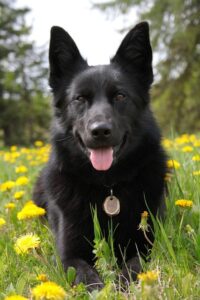Teaching your German Shepherd tricks can be a rewarding experience, strengthening your bond and providing mental stimulation for your dog. German Shepherds are known for their intelligence and eagerness to learn, which makes them the perfect candidates for trick training. Below, find steps for three easy tricks to teach your dog. Remember, positive reinforcement and patience are the secrets to successful dog training!
Table of Contents
The Science Behind Positive Reinforcement and Luring in Dog Training
Positive reinforcement and luring are two fundamental strategies widely used in dog training, both grounded in behavioral science. Positive reinforcement involves rewarding desired behaviors, encouraging the dog to repeat those behaviors in the future. This method leverages the principle that behaviors followed by pleasant outcomes are likely to be repeated. In the context of dog training, rewards can be treats, praise, or playtime—anything that the dog finds enjoyable.
Luring, on the other hand, involves guiding the dog into a desired behavior or position using a reward as a ‘lure’. Once the dog successfully follows the lure and performs the desired action, it is immediately rewarded. This technique effectively communicates to the dog what is expected without the need for force or compulsion. Over time, the lure can be phased out, and the dog will perform the behavior in anticipation of the reward.
Both techniques are underpinned by the science of operant conditioning, a theory of learning that emphasizes the role of rewards and punishments in shaping behavior. Positive reinforcement and luring are preferred for their ethical approach and effectiveness, promoting a trusting and positive relationship between the dog and its trainer.
Shake or Paw
This classic trick is a crowd-pleaser and the foundation for more complex tricks.
- Start with your dog in a sitting position.
- Hold out your hand near their paw.
- Your dog’s natural instinct may lead him to raise his paw in response.
- Treat and praise for any small movement of his paw towards your hand.
- Continue practicing and rewarding until he places his paw in your hand consistently, then offer a “jackpot” of extra treats and enthusiastic praise.
High 5
Building on the ‘Shake’ trick, ‘High 5’ takes your dog’s skill to the next level.
- Use the same steps as ‘Shake’, but each time raise your hand a bit higher.
- Once your hand is high enough, flip your hand around so that your palm faces the dog as he performs the ‘Paw’ trick.
- At this stage, there’s no need for a verbal command; your hand movement cues your dog. Once he smoothly transitions from ‘Paw’ to ‘High 5’, you can introduce a verbal cue.
Wave
The ‘Wave’ trick is an adorable way for your dog to say hello or goodbye.
- Begin with the ‘High 5’ hand motion (palm out) to prompt your dog.
- When your dog reacts by raising his paw, start to move your hand away before contact is made.
- The dog’s paw will follow the motion, resulting in a waving motion.
- Reward and praise generously for this cute behavior!
Training Tips for Success
- High-Value Treats: Always use treats that your dog is excited about to maintain motivation.
- Minimize Distractions: Start in a quiet place, then add distractions as your dog improves.
- Small Steps: Reward for incremental progress towards the final trick.
- Consistency is Key: Use the same commands and signals every time.
- Short Sessions: Keep training sessions brief to keep your dog engaged.
- End Positively: Finish each session on a good note, regardless of the outcome.
With these steps and tips, your German Shepherd will be impressing friends and family with his new repertoire of tricks in no time! Remember to add the verbal cues last as your dog is primarily responding to your hand signals during initial training. Practice regularly, be patient, and you’ll both enjoy the process of learning together.
German Shepherds love to work and must have a job. Tricks can be a fun part of giving them a job and a part of your daily training which is a must with these dogs. Remember to be patient and reward any small incremental step your dog males. He does not “know” what you want to begin with. However, GSD are very smart and Jasper learned these tricks in just a few session for each trick. I’d separate each iteration of the trick by a weeks or so.
Conclusion
Overall, training tricks can be beneficial for both you and your German Shepherd. It provides mental stimulation, strengthens the bond between you and your dog, and gives them a sense of purpose. With proper training techniques and consistency, your German Shepherd will be able to impress with their new skills. Remember to always reward and praise generously, stay patient, and have fun! Happy training


